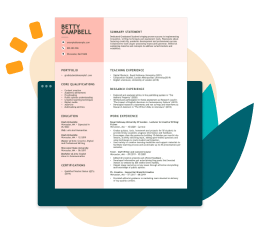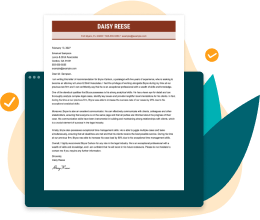How to Craft a Personal Mission Statement (45 Inspiring Examples)
What’s a personal mission statement? Get tips and examples to help you define the career values and goals that align with the life you want.
More than just a feel-good phrase, a clear mission statement helps you define your goals, values, and purpose, so you can target opportunities that truly align with who you are.
Whether you’re changing careers, entering the workforce for the first time, or looking to grow in your field, crafting a personal mission statement can keep you focused and help potential employers see exactly what makes you the right fit.
Keep reading for an in-depth guide to writing a personal mission statement and plenty of examples for top jobs and industries.
What Is a Personal Mission Statement?
A personal mission statement defines your strengths, what you want to accomplish in life, and what values motivate you to achieve your goals. It’s unique to you, and it can be a valuable reminder if your day-to-day starts to go off-track.
When developing a personal mission statement, you can include:
- Personal skills
- Professional skills
- Your current profession
- The role you aspire to have
- Financial, career, or personal goals
- What you want to contribute to society
- The people or values that motivate you
For example:
“To inspire a love of learning in every student, providing them with the tools they need to become curious, compassionate, and empowered global citizens.” —Sarah, a teacher
“To protect and restore our planet’s fragile ecosystems, fostering awareness, sustainability, and responsible stewardship for future generations.” —Elena, an environmental activist
“To push the boundaries of scientific knowledge and innovation, advancing our understanding of the natural world and addressing complex global challenges through research and discovery.” —Mercedes, a scientist
Why should you write a personal mission statement?
A well-crafted mission statement helps you clarify what truly matters to you, serving as a compass when deciding on a job, company, or entire career path. It’s an excellent tool for long-term career planning and staying focused on goals that align with your core values.
Defining your personal purpose also makes it easier to find employers whose culture and values match your own, giving you a clearer sense of the trade-offs involved in any new opportunity.
When you have a strong sense of what you want from your work life, you’re less likely to become disengaged or fall into the growing trend of “quiet quitting,” a symptom of workers feeling overworked or disconnected from their professional purpose.
The following people can benefit from writing a personal mission statement to help regain focus on their priorities and life path:
- High school students preparing for college or the workforce
- College students deciding on majors
- Recent graduates looking for entry-level jobs
- Professionals considering a career change
- Established professionals wanting to gain back their passion
How to Create a Mission
Statement for Yourself
Writing a personal mission statement requires introspection and self-awareness, but it can be broken down into a few simple steps.
Use these guidelines to write a personal mission statement to aid your career and personal development.
1Reflect on what’s important to you.
Think deeply about your core values, beliefs, and principles. What are the things that matter most to you in life? Consider your family, career, relationships, community, nature, or ethics. It’s essential to be as truthful as possible with this step. Don’t second-guess yourself or answer how you think society expects you to answer. The values you identify in this step will become the guiding principles of your life.
2Identify your passions and interests.
Recall your past jobs or hobbies to identify where you’ve excelled. Pay close attention to areas where you’ve consistently received recognition or tasks you’ve thoroughly enjoyed. These experiences will help you identify your core skills, including organization, planning, teaching, leadership, creative work, writing, athleticism, and more.
3Define your long-term goals.
Write down one or several goals you aspire to achieve in life. These goals should align with your values and passions. Ask yourself these questions to determine your long-term goals:
- Where would you like to be in your career in 5-10 years?
- Is there a particular job title that you aspire to have?
- What do you want to improve for others in your community?
- Do you have a lifelong dream you wish to fulfill, such as learning a new skill or starting your own business?
4Consider your legacy.
A great way to fine-tune your personal mission statement and add more context to what you want to do is by considering what you want to leave behind. Your actions throughout your life will have a lasting impact on the world. Ask yourself: “Is what I’m doing conducive to the legacy I want to leave?” or “What changes can I make in my life to leave a legacy I’m proud of?”
5Draft the statement utilizing what you’ve learned.
Once you’ve identified your values, passions, goals, and legacy, you can draft your personal mission statement. Ensure you use an affirmative voice and action verbs to create a strong mission statement that will inspire you through the process of making your professional dreams come true.
A good formula you can use to write a personal mission statement is as follows:
“I am committed to [your core values and beliefs] and strive to [your long-term goals and aspirations]. My mission is to [your mission or purpose] by [how you plan to achieve it] to [the impact or legacy you want to create].”
Here’s how to put it into action:
“I am committed to integrity, empathy, and continuous learning, and strive to create a life of purpose and fulfillment. My mission is to inspire and empower young people to reach their full potential by serving as a mentor and educator, guiding them toward a brighter future to leave a lasting legacy of empowered individuals who, in turn, uplift and inspire others in their communities.”
Personal Mission Statement
Examples to Inspire You
If you’re unsure about what to include in your personal mission statement, check out these mission statement examples and see what resonates with you:
For educators/teachers:
“I am committed to nurturing a love for learning and empowering students to become critical thinkers, lifelong learners, and responsible global citizens.”
“My mission is to create an inclusive and supportive classroom environment where every student can thrive academically and personally.”
For healthcare professionals:
“I am dedicated to providing compassionate and patient-centered care, prioritizing the well-being and dignity of every individual.”
“My mission is to advocate for health care equity and access, ensuring everyone receives the care they deserve.”
For environmentalists:
“I am passionate about protecting our planet and strive to inspire others to live sustainably, promoting a greener and healthier planet.”
“My mission is to work toward a future where humanity lives in harmony with nature, preserving biodiversity and combating climate change.”
For entrepreneurs:
“I am committed to innovation and entrepreneurship, aiming to disrupt industries, create jobs, and drive economic growth in my community.”
“My mission is to build a purpose-driven business that solves real-world problems while maintaining ethical business practices.”
For social workers:
“I am dedicated to advocating for the rights and well-being of marginalized communities, working to create a more just and equitable society.”
“My mission is to provide support and resources to individuals and families in crisis, helping them rebuild their lives with dignity and hope.”
For artists/creatives:
“I am passionate about using my creativity to inspire and evoke emotions, making art that connects people on a profound level.”
“My mission is to bring beauty and meaning to the world through my artistic expression, leaving a lasting impact on those who experience it.”
For tech innovators:
“I am committed to harnessing technology’s potential to solve pressing global issues, from healthcare advancements to sustainable solutions.”
“My mission is to make technology accessible and user-friendly, empowering people to navigate the digital age confidently.”
For nonprofit leaders:
“I am dedicated to creating positive social change by leading impactful nonprofit organizations that address critical community needs.”
“My mission is to mobilize resources and support to improve the lives of vulnerable populations, leaving a legacy of empowerment and resilience.”
For community organizers:
“I am committed to empowering communities to voice their concerns, advocate for change, and work collaboratively to create a more just and inclusive society.”
“My mission is to bridge divides, build connections, and foster a sense of unity among diverse groups in my community.”
For financial advisors:
“I am dedicated to helping individuals and families achieve financial security and independence through sound financial planning and education.”
“My mission is to demystify finance and make it accessible to all, ensuring everyone has the knowledge to make informed financial decisions.”
For humanitarian aid workers:
“I am committed to responding to humanitarian crises with unwavering dedication, delivering aid, hope, and support to those affected by conflict, disaster, and poverty.”
“My mission is to be a global advocate for peace, working tirelessly to prevent conflicts and alleviate the suffering of those in crisis.”
For lawyers/advocates:
“I am dedicated to upholding justice and the rule of law, advocating for the rights of the marginalized, and ensuring equal access to legal representation.”
“My mission is to use the power of the law to create a fair and equitable society where no one is above the law.”
For scientists/researchers:
“I am committed to pushing the boundaries of scientific knowledge and innovation, advancing our understanding of the natural world, and addressing complex global challenges through research and discovery.”
“My mission is to make science accessible and understandable to the broader community, fostering a spirit of curiosity and critical thinking.”
For athletes/sports professionals:
“I am dedicated to achieving excellence in my sport, serving as a role model for dedication, sportsmanship, and perseverance.”
“My mission is to use the power of sports to inspire and empower youth, promoting physical fitness and healthy lifestyles.”
For politicians/public servants:
“I am committed to serving my constituents with integrity, transparency, and a focus on the common good, striving to make positive changes in my community.”
“My mission is to be a tireless advocate for the needs and aspirations of the people I represent, working towards a fair and just society.”
For chefs/culinary professionals:
“I am passionate about creating memorable culinary experiences that celebrate culture, community, and the joy of food.”
“My mission is to promote sustainability and conscious eating, inspiring others to savor the richness of our planet’s culinary diversity.”
For engineers/innovators:
“I am committed to engineering solutions that improve lives and solve complex problems while always considering the ethical and environmental impacts.”
“My mission is to mentor and inspire the next generation of engineers, fostering innovation and creativity in the field.”
For historians/archivists:
“I am passionate about preserving our shared history and cultural heritage, ensuring that future generations can learn from the past.”
“My mission is to uncover untold stories and promote a deeper understanding of our collective human history.”
For journalists/writers:
“I am committed to pursuing truth, objectivity, and integrity in journalism, holding those in power accountable and informing the public accurately and fairly.”
“My mission is to use the power of words to inspire empathy, spark dialogue, and bring attention to critical issues that shape our world.”
For retailers/small business owners:
“I am dedicated to providing exceptional products and customer experiences while supporting my local community and promoting ethical business practices.”
“My mission is to build a thriving and inclusive business that contributes positively to the lives of my customers, employees, and the environment.”
For military personnel:
“I am dedicated to serving my country with honor, valor, and dedication, ensuring the safety and security of my fellow citizens.”
How to Use a Personal Mission Statement
1Use it to find jobs that match your mission.
A personal mission statement’s purpose is to constantly remind you of what you’re working toward. When you’re overwhelmed with choices about your career, it can help you filter out jobs that don’t fit your goals. As you browse for jobs, keep your mission statement in mind to apply to jobs where you can use your strengths, do what you’re passionate about, and align with your values.
2Use it to write your resume or cover letter.
Your personal mission statement can be edited into a resume summary or career objective to open your resume. You can also use it to highlight your professional identity when drafting a cover letter.
3Use it during job interviews.
Some interviewers might outright ask you “What is your personal mission statement?”, so it’s a good idea to have it memorized just in case. Even if they don’t ask you about it directly, they may ask some interview questions about your values, career goals, or what matters most about a job, and those can be answered with your personal mission statement.

PRO TIP
Using your mission statement to help write parts of your resume and cover letter is great, but be sure to include job-specific skills and keywords, too. If you need help writing your application documents, check out our Resume Builder and Cover Letter Generator.
The reviews are in!
See what they’re saying about us on Trustpilot.
Key Takeaways
- A personal mission statement helps you develop a clear vision of your personal and professional strengths and how you can use them to achieve your life purpose.
- Writing a mission statement can help you avoid distractions and stay focused on jobs and opportunities that align with your goals.
- Job seekers at any stage—students, graduates, career changers, or seasoned professionals—can benefit from clarifying their mission to avoid misaligned roles and workplace dissatisfaction.
- To write a good personal mission statement, start by reflecting on your core values, strengths, goals, and the legacy you want to create. Then, draft a concise statement that connects these ideas and guides your career choices.
- Use your statement to guide your job search, tailor your resume and cover letter, and articulate your goals in interviews. It’s a personal branding tool that shows employers exactly what drives you.
Frequently Asked Questions
Can I change my personal mission statement over time?
Yes. Your personal mission statement should change over time as you continue to achieve your goals and your priorities shift. Although your core values may not change, it’s always essential to continue pushing yourself with new learning challenges.
Is a mission statement the same as a vision statement?
A company’s mission statement focuses on concrete action plans and short-term goals, while a vision statement inspires and reflects its values and societal contributions. For individuals, this distinction usually doesn’t matter. Personal mission and vision statements are often interchangeable and serve to clarify values and long-term aspirations.
Featured in:*

*The names and logos of the companies referred to in this page are all trademarks of their respective holders. Unless specifically stated otherwise, such references are not intended to imply any affiliation or association with LiveCareer.













